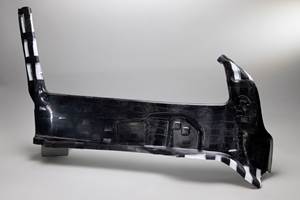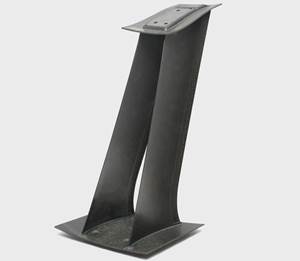Carbon fiber composites: The past can be the future
JIm Stike, of Materials Innovation Technologies – Reengineered Carbon Fibers (Fletcher, N.C.), points to progress in the reclaiming of waste and end-of-life carbon fiber.
Recycling. Repurposing. “Green” solution. Environmentally
friendly. Cradle to grave. Cradle to cradle. Zero land fill.
Until recently these descriptors and phrases have been absent from the lexicons of most composites companies.
Not that everyone has been ignoring this issue. In fact, I keep a copy of a May 2007 High-Performance Composites article on the subject of recycling carbon fiber right here on my desk as a motivator and reminder that talk is cheap, but a cost-effective solution requires hard work (see “Carbon fiber: Life beyond the landfill," under "Editor's Picks, at top right”).
Our company, Materials Innovation Technologies, started out as an advanced-materials engineering company that had a very interesting idea: Manipulate chopped fibers (1 inch/25.7 mm in length) in a slurry-molding process to produce complex-shaped preforms.
In 2005, the U.S. Department of Energy (DoE) was looking for innovative processes that could reduce the cost of manufacturing lightweight automotive components. Mass reduction equates to better fuel efficiency in cars powered by internal combustion engines or hybrid-electric power plants. In the case of battery electric vehicles, it equates to a greater driving range between charges. Automotive lightweighting was a technical topic for the DoE’s Small Business Innovation Research (SBIR) program, and my company was fortunate enough to win a Phase I award of $100,000 to demonstrate that we could cost-effectively replace a metal automotive component with one of chopped carbon fiber-reinforced polymer. Later, a North Carolina state match, an SBIR Phase II award, a Supplemental award and a Phase III Commercialization award turned our initial SBIR into $4.2 million worth of development funding and, more importantly, into three excellent automotive parts that had high potential for commercial production.
(As a side note, let me add a word of encouragement, based on our experience. Small business owners in the U.S. owe it to themselves and to their companies to learn about, understand and then participate in the federal government’s SBIR program. Yes, the paperwork can sometimes be a hassle, and yes, it is a highly competitive process. But if your company has a solution to a problem, and if your team can manage projects on time and on budget and deliver results, then I highly recommend these programs. You can begin your learning process at www.grants.gov.)
When we began our work, we focused on using virgin carbon fiber and quickly learned that glass, aramid, quartz, natural fibers (including jute, kenaf, flax and coir) and thermoplastic fibers worked equally well in our 3-DEP (three-dimensional engineered preform) process. But we soon turned to reclaimed fiber. When fiber is reclaimed from a composite material or component, it cannot be preserved in its continuous or woven form. The fiber that remains is of good quality, but in discontinuous form. It is typically chopped fiber. We started using fiber reclaimed from all a variety of carbon fiber scrap — from dry continuous fiber to wovens, uncured prepregs and cured prepregs — and we also moved into end-of-life components and reclaimed those carbon fibers and reused them. Today, recycled chopped fiber from these sources is used cost-effectively in our 3-DEP process to produce very uniform, high-quality preforms. We have taken end-of-life composite aircraft parts, well-used (some would say abused) composite hockey sticks and old carbon-fiber bicycle frames and turned them into lightweight automotive components.
Nine out of 10 times, when I ask carbon fiber producers, converters or molders what they do with their in-process scrap, the answer is, “We throw it in a dumpster and send it to the landfill.” But companies like ours are proving that recycling is viable and that reclaimed fibers can be used successfully in many applications. We now offer a better waste-disposal solution, both environmentally and commercially, to molders who use virgin fiber. We are working with numerous companies, first to keep their composite scrap out of landfills — we are approaching 1 million lb (453.6 metric tonnes) of scrap reclaimed — and more importantly, we’re helping them to close the loop and turn their waste fibers into reengineered carbon fiber composite parts. It’s time to turn carbon fiber’s past into its future.
Related Content
Composite resins price change report
CW’s running summary of resin price change announcements from major material suppliers that serve the composites manufacturing industry.
Read MoreHighly tunable, woven lattice reinforcements target automotive structures
CAMX 2023: Startup Weav3D will be demonstrating its two collaborative automotive demonstrator parts and present two conference papers.
Read More3D weaving capabilities achieve complex shapes, reduce weight and cost
JEC World 2024: Bally Ribbon Mills is displaying film-infused 3D woven joints, woven thermal protection systems (TPS) and woven composite 3D structures.
Read MorePEEK vs. PEKK vs. PAEK and continuous compression molding
Suppliers of thermoplastics and carbon fiber chime in regarding PEEK vs. PEKK, and now PAEK, as well as in-situ consolidation — the supply chain for thermoplastic tape composites continues to evolve.
Read MoreRead Next
Carbon fiber: Life Beyond the Landfill
Reclamation technologies give scrapped aerospace-grade carbon fiber new possibilities and a lower price point in nonstructural/conductive applications.
Read More“Structured air” TPS safeguards composite structures
Powered by an 85% air/15% pure polyimide aerogel, Blueshift’s novel material system protects structures during transient thermal events from -200°C to beyond 2400°C for rockets, battery boxes and more.
Read MoreAll-recycled, needle-punched nonwoven CFRP slashes carbon footprint of Formula 2 seat
Dallara and Tenowo collaborate to produce a race-ready Formula 2 seat using recycled carbon fiber, reducing CO2 emissions by 97.5% compared to virgin materials.
Read More










.jpg;maxWidth=300;quality=90)











